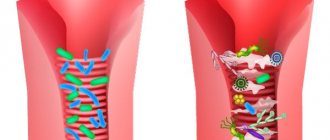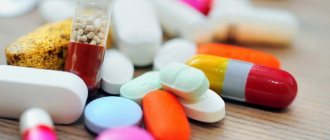Why does the gut need bacterial diversity?
The human intestine contains trillions of bacteria, which can be divided into good, neutral and bad (pathogenic). Normally, a balance is maintained between them - the good ones maintain order in the intestines, preventing pathogenic ones from multiplying and causing chaos.
The intestinal microbiota is a smart ecosystem that is responsible for the breakdown of food, the synthesis of beneficial acids and vitamins, the protection and strengthening of the immune system and intestinal walls. When one type of good bacteria dies, a group of others comes to the rescue and takes over their functions. But this only happens if the microbiota is sufficiently diverse.
From the very first days of our lives, intestinal bacteria learn to interact with the immune system so that it recognizes and attacks only foreign microorganisms. But when the microbiota is not balanced, there is a risk that communication with the immune system will be disrupted, and it will direct its destructive effect against the host body.
Microbiota. What kind of organ is this and why do we need it?
When several types of good bacteria die, immunity decreases. This allows pathogens to multiply, increasing the risk of infection and inflammation.
Intestinal microflora and the outside world
There are a huge number of microbes around us. These microbes are more ancient than us, than humanity. The task of this flora is to infiltrate each of us, live and reproduce at our expense. They are always looking for weak points. We are open to bacterial flora from the outside world, but we have our defenders everywhere: bifidobacteria, lactobacilli and typical E. coli.
Without bifidobacteria, lathobacteria and the typical E. coli, the immune system would not work! Bifidobacteria and lactobacilli are the body's natural defense against harmful bacteria, viruses, fungi, and protozoa. We must keep our flora in order, constantly feed it, give it a sufficient amount of carbohydrates, vitamins, microelements, and fluids.
What antibiotics exist and their principle of action?
Antibiotics are prescribed for bacterial infections that are difficult to treat. The principle of their action is the fight against pathogenic bacteria. Antibiotics prevent microorganisms from multiplying or completely destroy them.
If it is not known which bacteria is causing the inflammation, broad-spectrum antibiotics are used - they destroy both bad and good bacteria.
Antibiotic groups
Most antibiotics can be divided into six groups:
| Antibiotic | Application |
| Penicillins (penicillin, amoxicillin) | Infections, including skin, chest and urinary infections. ways |
| Cephalosporins (cephalexin) | A wide range of infections, as well as sepsis and meningitis. |
| Aminoglycosides (gentamicin, tobramycin) | Serious infectious diseases such as sepsis. They are used mainly in medical institutions, as they can cause serious side effects. reactions |
| Tetracyclines (tetracycline, doxycycline) | Acne and rosacea. |
| Macrolides (erythromycin, clarithromycin) | Infections of the lungs and chest, penicillin-resistant strains of bacteria, allergies to penicillin. |
| Fluoroquinolones (ciprofloxacin, levofloxacin) | Respiratory and urinary tract infections. No longer used regularly due to the risk of serious adverse reactions. |
When to use antibiotics
The inappropriate and frequent use of antibiotics worries the medical and scientific communities. Experts recommend using antibiotics only in the following cases:
- Diseases that are difficult to cure without the use of antibiotics;
- Diseases with a high risk of transmission to other people;
- Diseases for which the treatment period without the use of antibiotics is too long;
- Diseases with a risk of serious complications.
People at high risk, such as those with chronic illnesses, are sometimes prescribed antibiotics as a preventive measure.
The action of antibiotics is aimed only at bacteria; they are powerless against viruses.
Therefore, to prescribe an antibiotic, you need to make sure that the source of infection is a bacteria and not a virus. Only a doctor can distinguish a bacterial infection from a viral one.
How our microbes make us who we are
Some scientists believe that intestinal bacteria help the virus spread more actively in the body. Therefore, one way to fight infection when the immune system is weakened is to reduce bacterial diversity. In this regard, antibiotics are sometimes prescribed for viral diseases, for example, for the COVID-19 coronavirus.
With viral diseases, immunity is weakened, and the body becomes more vulnerable to pathogens and the development of bacterial infections, which can complicate treatment, especially if the disease is severe.
Previously, scientists believed that the lungs were sterile. However, in 2022, it was suggested that this is not the case, and the lungs are directly related to the intestinal microbiota. Therefore, gut bacteria, including good ones, may play a role in treating lung disease. Antibiotics deprive her of this opportunity by destroying bacteria.
How medications affect the composition of gut bacteria
Antibacterial drugs can save lives. When the patient truly needs them, their benefits outweigh the potential risks. But if they are used for other purposes, they will not only not help, but will also harm the body.
In 2011, the All-Russian Center for Public Opinion Research conducted a survey. The results showed that 46% of Russians consider antibiotics to be as effective against viruses as against bacteria.
Antibiotics should be taken as prescribed by a doctor. Only a specialist can correctly assess the potential benefits and risks of taking them.
The benefits of fermented milk products
As you know, one of the main sources of beneficial bacteria for humans is fermented milk products. In stores, the choice of fermented milk products is now quite wide, and some of them are additionally enriched with bifidobacteria and lactobacilli. Is it possible to include kefir or yogurt in your diet daily without worrying about your intestinal microflora? Unfortunately no.
Firstly, many fermented milk products have a fairly long shelf life, which is achieved through sterilization and ultra-pasteurization of the product. As a result of such processes, not only harmful but also beneficial bacteria die, which significantly reduces the value of the product.
Secondly, in the production of fermented milk products, the types of bacteria that our body needs are often used, but those that are more convenient for the manufacturer to work with. For example, in the production of yoghurt, starters containing Bifidobacterium animals are actively used, which are found in small quantities in the human body and are not very characteristic of it.
If you want to eat fermented milk products that actually contain beneficial bifidobacteria and lactobacilli, then buy kefir and yoghurt with a short shelf life (no more than 5-7 days). Another option is to prepare fermented milk products at home yourself based on milk and dry starter cultures .
In what cases can you cope without antibiotics?
Doctors often mistakenly prescribe antibiotics for infections caused by viruses, or prescribe a broad-spectrum drug when it is necessary to use drugs aimed at combating only certain bacteria.
In the past, antimicrobials were used to treat chest infections, ear infections in children, and sore throats. With the development of science and medicine, it became clear that the treatment of these conditions can be done without antibiotics.
Types of diseases that are not recommended to be treated with antibiotics without a doctor's indication:
- Cold/runny nose;
- Bronchitis/chest cold in healthy children and adults;
- Flu;
- Sore throat (except for streptococcal infection);
- Fluid in the middle ear (otitis media with effusion).
Berries, herbs, vegetables, fruits
Our ancestors actively used berries, onions, garlic, horseradish, and herbs for food. On the one hand, all this was easy to collect in the forest or grow in the garden, but, on the other hand, it was of great value to the body. Many berries and herbs contain a lot of useful vitamins and minerals, and, in addition, help the body fight opportunistic flora.
Vegetables and herbs that inhibit the growth of opportunistic microflora
| Product | Inhibitory effect on microorganisms |
| Carrot | salmonella, clostridia |
| Onion | Escherichia |
| Black radish | Proteus, Klebsiella, Pseudomonas aeruginosa |
| Capsicum | proteus, klebsiella, mushrooms |
| Garlic | Proteus, Klebsiella |
| Horseradish | Proteus, Klebsiella, Pseudomonas aeruginosa |
| Dill | Proteus, Klebsiella |
| Caraway | Proteus, Klebsiella |
| Carnation | Escherichia, Proteus, Klebsiella, mushrooms, Pseudomonas aeruginosa |
Fruits and berries that inhibit the growth of opportunistic microflora
| Product | Inhibitory effect on microorganisms |
| Raspberries | staphylococcus, streptococcus, shigella, enterococcus |
| Barberry | staphylococcus, streptococcus, shigella, enterococcus |
| Blueberry | Staphylococcus, Proteus, Klebsiella, Enterococcus, Shigella |
| Rose hip | staphylococcus, escherichia |
| Cowberry | mushrooms |
| Apricot | Proteus, Klebsiella, Pseudomonas aeruginosa, Staphylococcus |
| Pomegranate | Shigella, Escherichia |
| Dogwood | shigella, salmonella |
| Cranberry | Proteus, Klebsiella, Shigella, Salmonella |
How antibiotics affect the body
Despite the effectiveness of antibiotics in fighting bacterial infections, taking these drugs is associated with a number of adverse reactions.
Allergic reactions . In the United States, 140,000 people are admitted to the emergency room each year with allergic reactions to antibiotics. Such reactions include:
- Rash;
- Itching;
- Diarrhea, constipation, bloating;
- Swelling of the face and respiratory tract;
- Breathing problems.
Some studies show that antibiotic use in children's first year of life increases the risk of asthma, allergic reactions and autoimmune diseases. Scientists also believe that these drugs play a role in the development of obesity.
Antibiotic resistance. According to the World Health Organization (WHO), the number of deaths from infectious diseases is expected to rise sharply in the coming decades. This is due to the resistance that bacteria develop to the antibiotics used.
According to statistics, global antibiotic use increased by 39% between 2000 and 2015.
Increased risk of infection with the pathogenic bacterium Clostridium difficile C. difficile causes enterocolitis, the symptoms of which can range from mild diarrhea to sepsis. When you take antibiotics, the bacteria that protect your intestines from infection are killed. This is when it is easier for C. difficile to enter the body and trigger inflammation. The main sources of this pathogen are contaminated surfaces, especially in healthcare facilities.
Imbalance of intestinal bacteria Widespread use of antibiotics does not only lead to bacterial resistance to drugs. It also causes an imbalance in the intestinal microflora, which in the long term can lead to metabolic disorders and disruptions in the immune system.
The most common types of microorganisms that inhabit the gastrointestinal tract
If you start taking a course of antibiotics, be sure to finish it completely, even if you start to feel better. Premature termination of the course contributes to the development of bacterial resistance to the antibiotic and increases the risk of re-infection.
How to take antibiotics correctly
The instructions for use or doctor's prescription for each antibiotic usually indicate how to take it - with or after meals. Following the rules is the key to the effectiveness of drugs and good health - some antibiotics must be taken with food to avoid adverse reactions such as nausea or vomiting.
In addition, some foods do not mix well with antibiotics:
Grapefruit pulp and juice affect the functioning of enzymes responsible for breaking down antibiotics. As a result, the effectiveness of the drugs decreases or, conversely, increases, and adverse reactions intensify. You should completely avoid consuming this fruit in any form while taking it.
Avoid grapefruit and grapefruit juice while taking antibiotics
Foods fortified with calcium reduce the effectiveness of antibiotics. Consult your doctor and follow medication instructions to avoid this.
Alcohol is associated with three potential risks when taking antibiotics. The drugs can cause increased absorption of alcohol and lead to greater intoxication. The risk of adverse reactions increases: nausea, vomiting, drowsiness. Combining alcohol with certain types of antibiotics, such as isoniazid, destroys healthy liver cells.
Some juices and caffeinated drinks may interact with medications, which may reduce their effectiveness or cause additional side effects. It is recommended to take antibiotics with water.
Why is Polysorb right for you?
- Recommended for use by people of all ages.
- Does not contain preservatives, dyes or sweeteners. Neutral in taste.
- Gently removes harmful substances and normalizes intestinal microflora.
The dosage of the drug is calculated individually depending on its weight according to the instructions.
If you have difficulty calculating the individual dose of Polysorb, you can get a free consultation by phone: 8-800-100-19-89 or in the consultation section.









